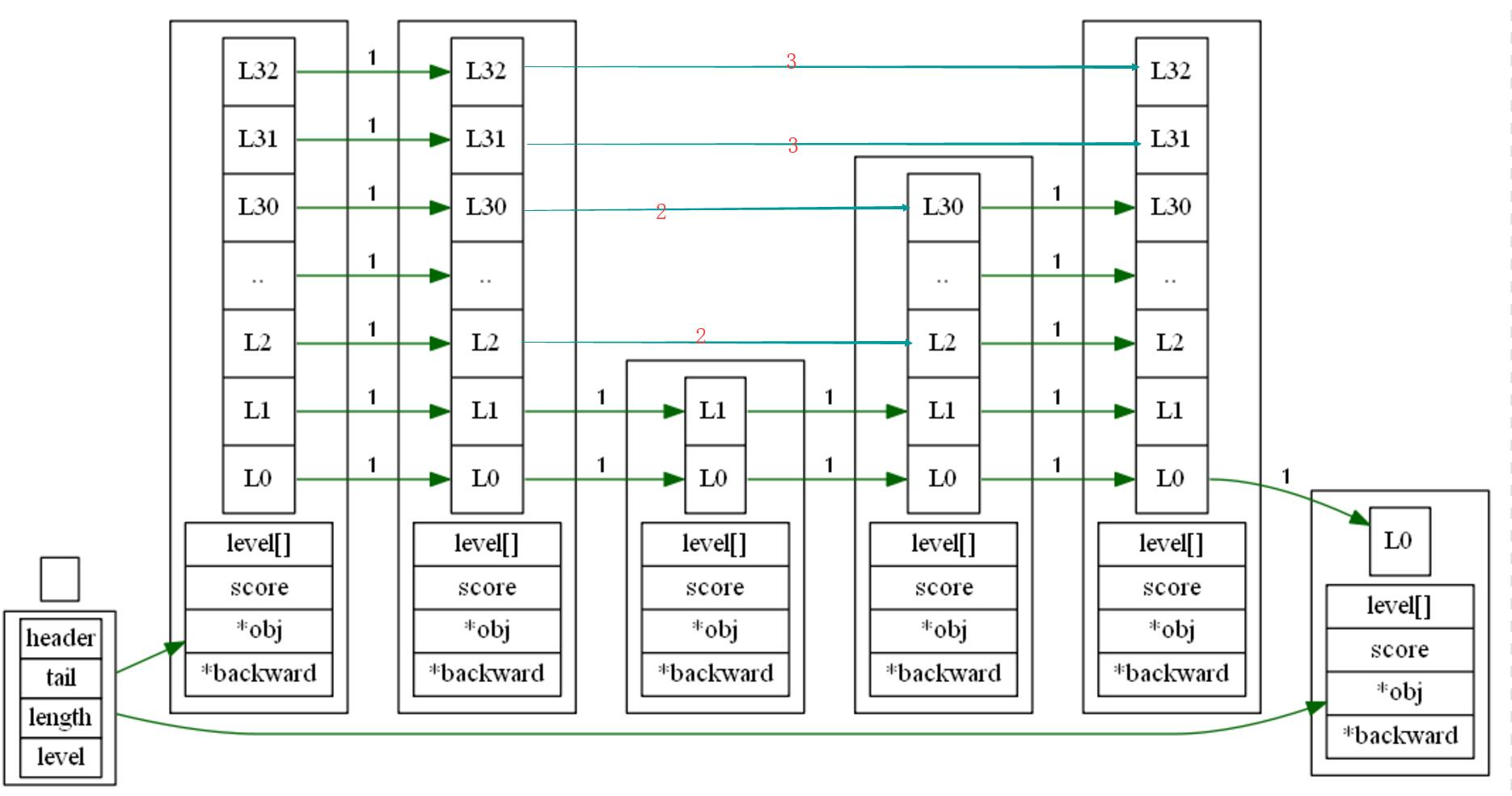底层原理
跳跃表:可以实现链表O(logN)的时间复杂度找到插入位置;空间复杂度为O(N)比一般的链表要多额外的存储空间来存储索引节点;
以下是redis中跳跃表的结构
typedef struct zskiplistNode {//跳跃表节点
sds ele; //值,sds结构
double score; //分数,根据分数来排序
struct zskiplistNode *backward; //前驱节点
struct zskiplistLevel { //层,数组,新建时随机建立层数,不过越高概率越低
struct zskiplistNode *forward; //对应层的下一个节点
unsigned long span;//与同层的下一个节点之间的跨度(距离)
} level[];
} zskiplistNode;
typedef struct zskiplist {//跳跃表链表结构,
struct zskiplistNode *header, *tail; //头尾指针
unsigned long length;//跳跃表节点个数
int level; //最高层的层数
} zskiplist;
插入一个新节点
zskiplistNode *zslInsert(zskiplist *zsl, double score, sds ele) {
zskiplistNode *update[ZSKIPLIST_MAXLEVEL], *x; //存储新节点每一层的前驱节点
unsigned int rank[ZSKIPLIST_MAXLEVEL]; //存储新节点每一层前驱结点距离头的跨度
int i, level;
serverAssert(!isnan(score));
x = zsl->header; //从头节点开始寻找
for (i = zsl->level-1; i >= 0; i--) {//从最顶层开始找
/* store rank that is crossed to reach the insert position */
rank[i] = i == (zsl->level-1) ? 0 : rank[i+1]; //累加上一层得到的rank
//如果当前层有后继节点,且该节点分数小于等于新节点分数||键值字典比较小于新节点
while (x->level[i].forward &&
(x->level[i].forward->score < score ||
(x->level[i].forward->score == score &&
sdscmp(x->level[i].forward->ele,ele) < 0)))
{
rank[i] += x->level[i].span; //加上跨度
x = x->level[i].forward;//则x指向为下一个节点
}
update[i] = x; //获得新节点每一层的前驱节点
}
/* we assume the element is not already inside, since we allow duplicated
/* scores, reinserting the same element should never happen since the
/* caller of zslInsert() should test in the hash table if the element is
/* already inside or not.
level = zslRandomLevel();//为新节点随机获取层数
if (level > zsl->level) { //如果大于当前最大层
for (i = zsl->level; i < level; i++) {
rank[i] = 0; //
update[i] = zsl->header;
update[i]->level[i].span = zsl->length;//?????
}
zsl->level = level;
}
x = zslCreateNode(level,score,ele);
//交换指针指向,还有根据rank据算跨度
for (i = 0; i < level; i++) {
x->level[i].forward = update[i]->level[i].forward;
update[i]->level[i].forward = x;
/* update span covered by update[i] as x is inserted here */
x->level[i].span = update[i]->level[i].span - (rank[0] - rank[i]);
update[i]->level[i].span = (rank[0] - rank[i]) + 1;
}
/* increment span for untouched levels */
for (i = level; i < zsl->level; i++) {
update[i]->level[i].span++;//新节点直接前驱中比level更高的层跨度+1;
}
x->backward = (update[0] == zsl->header) ? NULL : update[0];
if (x->level[0].forward)
x->level[0].forward->backward = x;
else
zsl->tail = x;
zsl->length++;
return x;

通过分析代码知道大致流程(每一层其实都是指向后继节点的,为了方便说明会指出每一层的前驱节点,实际上并没有指向前驱,而且这里的前驱与backward不同,是指每一层之间的关系,而backward是最底层直接相邻的前一个节点)
-
1)先从header开始一层一层的往下判断,如果当前层的下一个节点满足有后继节点,且该节点分数小于等于新节点分数 键值字典比较小于新节点,那么从当前层的后继结点开始继续往下找; - 2)在找的过程中不断获取新节点每一层的直接前驱节点,存入updata数组中,并不断获取新节点每一层的直接前驱节点距离头节点之间的距离,存入rank数组中;最后抵达最后一层,也就找到了要插入的位置位于当前节点的右边;
- 3)随机生成一个level,代表层数,如果level大于当前最大层,那么超过的层的直接前驱是header,且跨度为当前位置到头节点之间的距离;
- 4)之后就是遍历update,设置新节点每一层的节点关系和跨度;
- 5)如果level小于最大层数,那么还需要将update中上一部没有操作到的层的跨度+1;
- 6)最后就是设置新节点的前驱节点(backward);
之后删除,查询的大致思路也是类似,从头部开始一层一层往下找,直到最后一层;查询的过程中可以累加跨度,从而得到他的在链表中的位置,即排名;